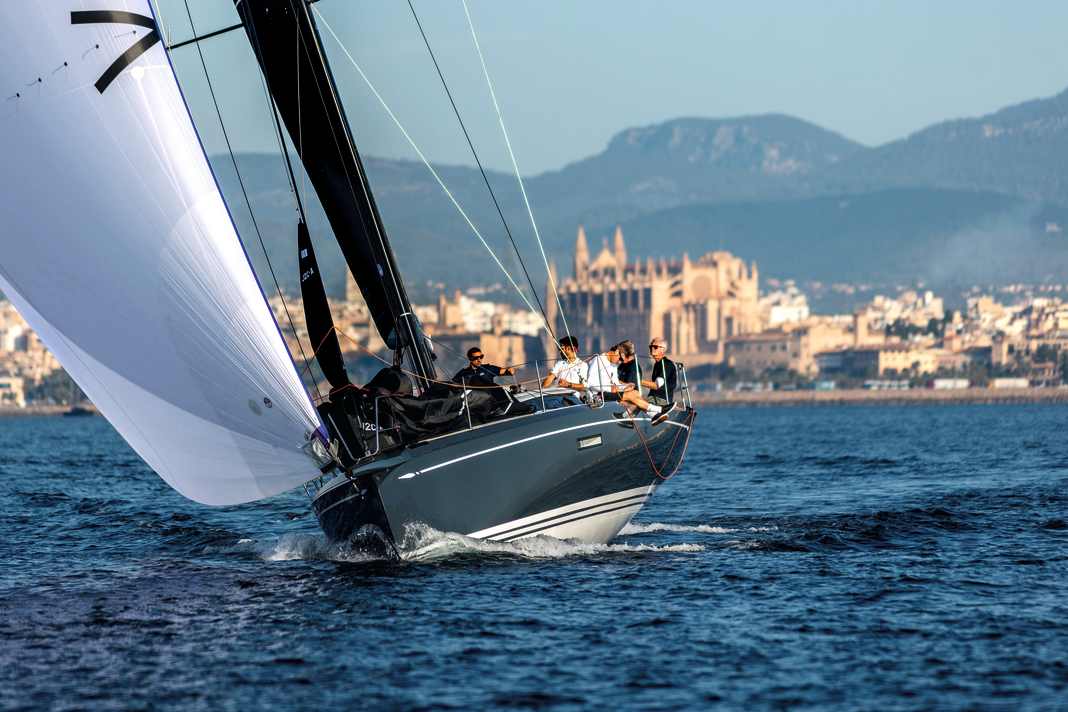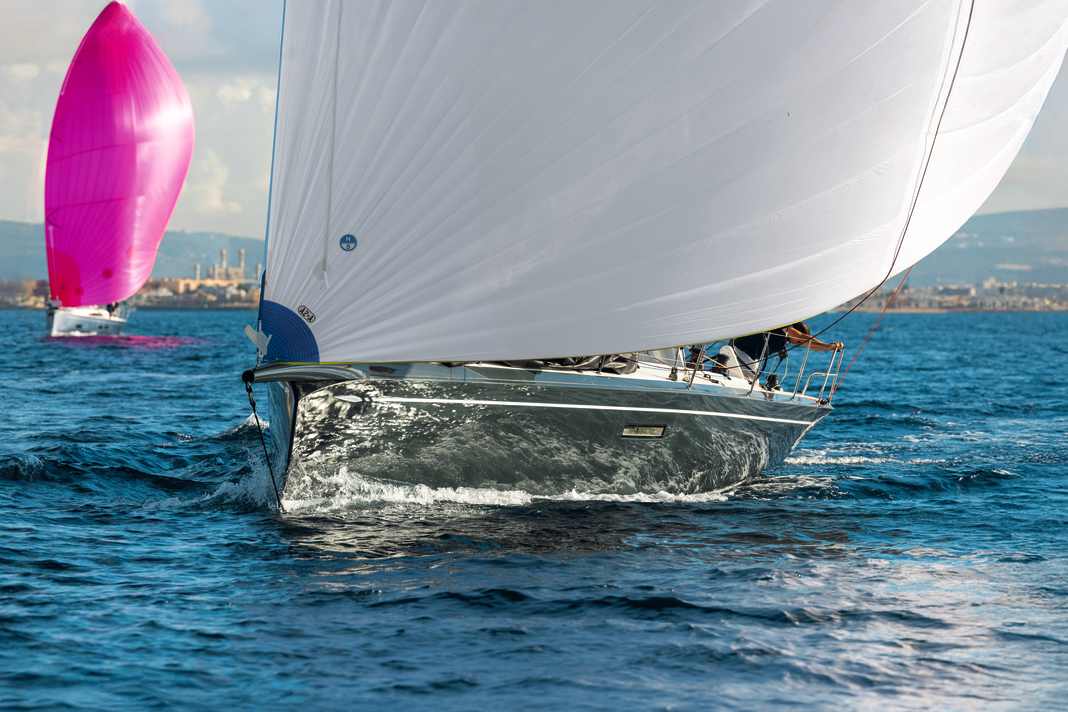





It was already clear by mid-2023 that the yacht market would not be sailing under full sail for much longer. After the pandemic-induced boom of previous years, order lists thinned out and then sales figures plummeted like the wind in the eye of a low-pressure vortex. As a result, many shipyards cancelled or postponed their development projects. Beneteau, for example, the global market leader, did not launch a single new boat on the market in 2024. For others, completion was delayed by months.
For the vote for European Yacht of the Year, in which only newcomers can take part, this meant that the number of nominees who actually took part in the tests was almost halved. A sad development only in parts. After all, the boats that came to Kiel-Schilksee and Palma de Mallorca consistently gave very strong performances in easy to challenging conditions.
While the Kiel Fjord was the venue for the rigorous practical testing for the second time, the jury made up of the heads of Europe's twelve most important sailing magazines visited the Balearic island for the first time. The Club de Mar cleared the tip of the outer pier especially for the event. The candidates were in illustrious company, surrounded by superyachts up to 60 metres long. Even the Contest 63 CS, the longest boat among this year's nominees, no longer seemed so big.
One trend can be observed across almost the entire fleet, from daysailers to racers, from cruising boats to performance catamarans: more and more variability. Whether in terms of propulsion, cabin layout or basic design, manufacturers are increasingly trying to appeal to several target groups with one model. Perhaps the greatest balancing act in this respect is the ClubSwan 43, a one-design racing yacht from Nautor that can be converted into a sporty cruiser with little effort.
Something else is striking this year: the French have never been less dominant. With 38 overall victories, they continue to lead the all-time leaderboard. This year, however, they only added one title to their impressive collection; the other four went to other countries. Germany consolidated its second place, while the Netherlands moved up one position to third place, which it shares with Denmark and Italy. Read here which yachts made it to the top and what characterises them.
Winner Cruising Boats - The Universalist
Hanse 360

The yacht from Greifswald had to hold its own against strong French competition. It was helped to victory by its solid structure, precise manoeuvrability and maximum broadband.
She is indeed wide. At just under four metres, the Hanse 360 is on a par with yachts that are longer in the hull - such as the Bavaria C38 or the RM 10.80. Her extreme length/width ratio of 2.6 and the strong upturn in the bow not only set Olivier Racoupeau's design apart visually. Above all, the space below deck sets her apart from the majority of the market. You have to get used to both. In fact, the Hanse 360 is closer to a 40-foot yacht than its direct competitors. Where the aft berths in the three-cabin version are otherwise only suitable for children, she offers adequate guest cabins for two adults each. There is no lack of volume anywhere else either: galley, foredeck, saloon - everything is great, apart from the almost vertical backrests of the seating area. The Hanse also derives a good part of its (dimensional) stability from its large width; the ballast ratio, on the other hand, remains low at just 23 per cent. Nevertheless, she sails stiffly under normal conditions and can easily carry a gennaker or code zero. The torsion-free floor assembly and a backlash-free, almost surgically precise rudder action convey a great deal of safety, indeed: sailing pleasure. You should only invest in larger winches and a genoa to realise the full potential. Just like some of the extras. The many extras make the Hanse 360 very customisable - and potentially expensive. Nevertheless, it is a solid, good buy!
Technical data
- Torso length: 10,60 m
- Width: 3,99 m
- Draught/old: 2,05/1,65 m
- Weight: 7,8 t
- Ballast/proportion: 1,8 t/23 %
- Sail area/STZ: 60 m²/3,9
- Base price ex shipyard: 221.220 €
Voices of the jury
"She fulfils almost all the requirements of a modern family cruiser," says Roland Regnemer from the Austrian YachtRevue. Alberto Mariotti, Editor of Superyacht24 in Italy, sees it the same way: "Quality, performance and volume: this boat has all the qualities to become a reference for the sector. The motto is versatility."
Strengths
Torsionally rigid body, high stability
Precise control, even with more wind
Plenty of space below deck, good berth dimensions
Very good ventilation
Very high customisability
Weaknesses
Fully equipped relatively expensive
Slightly under-rigged with self-tacking jib
Winner Performance Cruiser - The dancer
J/40
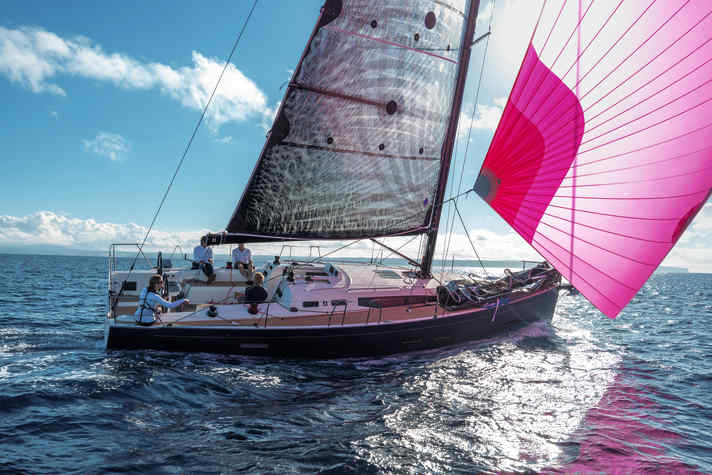
Its timeless aesthetics make it stand out from the crowd. When the sails are up, it is even more impressive: with performance and an almost inspiring light-footedness.
The US brand with production in the Vendée-Globe stronghold of Les Sables-d'Olonne broke new ground early on. It was one of the first shipyards to use Gurit's advanced sprint process for hull construction, in which pre-impregnated fibres are infused under vacuum and then annealed. J Boats also made the switch from spinnaker to gennaker at the forefront. Recently they have been less bold. They deliberately did not follow the trend towards hard chines and ever wider sterns in order to maintain the best possible upwind characteristics. However, their evolutionary rather than revolutionary approach has secured them a firm place in the performance cruiser market. The J/40 is a perfect example of this: with its elegant, timeless hull lines, the extremely responsive centre rudder that can be operated with just two fingers, a proven, highly efficient cockpit layout and the finely balanced sail plan, it was able to impress in the test under all conditions. Although she appears almost modest, this yacht will never cease to inspire. She is a stunner, especially in terms of longitudinal dynamics. And it is even convincing in terms of cruising comfort. Sure, there are performance cruisers in the 40-foot class with more elaborately designed interiors. However, these do not have the same agility and also cost more. If you prioritise performance over luxury, you should definitely take a closer look at the J/40.
Technical data
- Torso length: 12,47 m
- Width: 3,86 m
- Draught/old: 2,20/1,92 m
- Weight: 7,7 t
- Ballast/proportion: 2,9 t/38 %
- Sail area/STZ: 96 m²/5,0
- Base price ex shipyard: 374.820 €
Voices of the jury
"It's the boat for all those who think that modern yacht design has gone too far," says Axel Nissen-Lie, editor-in-chief of the Norwegian Seilmagasinet. Sebastien Mainguet from Voiles & Voilier in France calls the J/40 "a dream boat that sails fast in all conditions. In light winds, it always reaches the wind speed or even more".
Strengths
Very good sailing characteristics
Narrow turning angle
Fine feedback from the rudder
Good cockpit ergonomics
High-quality fittings
Weaknesses
Uninspired interior design
Three cabins with little storage space on deck
Sieger Multihulls - The all-rounder
Nautitech 48 Open
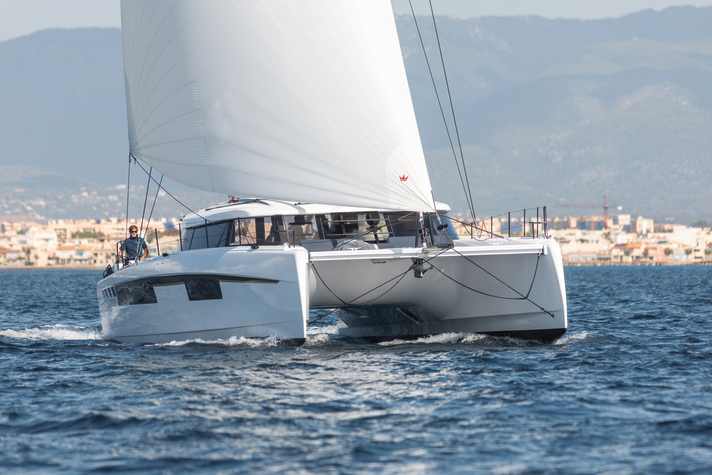
The top model from the Kat shipyard, which is part of the Bavaria holding company, is impressive across the board - not least under sail.
The first victory for the boat builders from Rochefort, just 40 kilometres south of La Rochelle, was only two years ago. Back then, the 44 Open won the title. And it is not at all easy to repeat such a success with a boat that is very similar in concept. But the French shipyard has managed it, even against strong competition from market leader Lagoon. The decisive factor was once again the very good overall package, especially at sea. In fact, the Nautitech 48 Open sails even better than its recognised potent sister model. The differences in the hull design may be subtle, but they are highly effective: with less keel rocker, more mast drop and a narrower waterline aft, the cat is very pleasant to handle, heels easily when powered and gets over or through the waves effortlessly. At less than 100 degrees, the turning angles remain quite low for this type of boat, and the response behaviour to gusts is amazing for such a large boat. And with a top speed of 12.8 knots under gennaker with a moderate 16 knots of true wind, the Nautitech was one of the fastest among the nominees. While other multihull brands offer even more volume and more comfort, it does not disappoint when it comes to long-distance sailing. So here is the almost perfect balance of enjoyable performance and plenty of comfort that can even delight monohull fans.
Technical data
- Torso length: 14,67 m
- Width: 7,79 m
- Draught/old: 1,55 m
- Weight: 13,5 t
- Sail area/STZ: 136 m²/4,9
- Price ex shipyard: 1.189.760 €
Voices of the jury
"There are cruising catamarans and performance cats. And then there's the Nautitech 48 Open, which combines the best of both worlds," says Marinus van Sijdenborgh de Jong, head of testing at the Dutch magazine Zeilen. Pasi Nuutinen from Vene in Finland summarises the boat in two words: "a pleasure!"
Strengths
Very balanced construction
Good sailing and manoeuvring characteristics
High speed potential
Variable-use lounge
Above-average structural strength
Weaknesses
Restricted view through the deckhouse
High price, but good equipment
Winner Special Boats - The revelation
Bay Cruiser 21
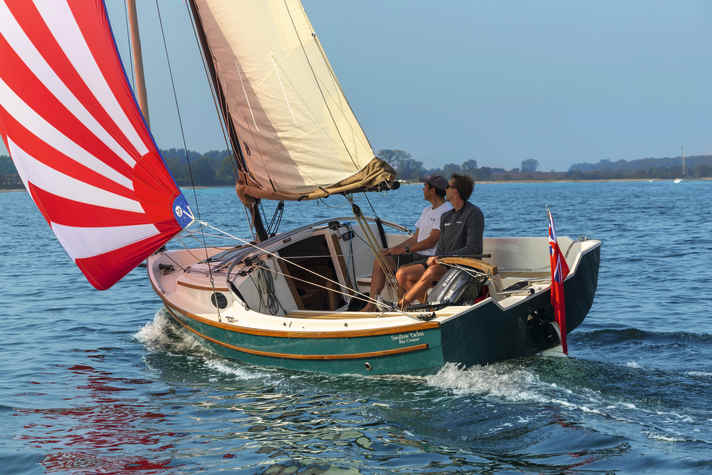
The smallest of the finalists showed many strengths in the test, even in strong winds: a real surprise package.
Swallow Boats from the United Kingdom may not be a brand name that everyone is familiar with. But for those who know it, it is synonymous with seaworthiness and ingenuity. The new Bay Cruiser 21 is the best boat yet from the resourceful Brits. It won the hearts and minds of the jury with its super-sympathetic practicality and ingenious simplicity. Even with a large outboard engine, which - when tilted up from the stern well - severely restricts the rear part of the cockpit, the cockpit is still large enough to accommodate four people. If you order a compact electric motor instead, you gain additional freedom of movement. The one-room cabin is also surprisingly easy to use. The backrests suspended from a rail allow comfortable seating with plenty of headroom for a small cruiser of only six metres in length; as inlay boards, they create a comfortably wide V-berth - who needs more on a weekend cruise? The Bay Cruiser 21 left the strongest impression in fresh conditions on the Kiel Outer Fjord. Even at 5 to 6 Beaufort, she tracked effortlessly, fought her way bravely through the short, steep waves at the cross and even drifted under her fractional gennaker to almost double-digit peak values. If the wind is moderate, she sails stiffly enough without water ballast. Another point in her favour is that she only needs a shore berth and a trailer, as she can be launched via a ramp and made ready to sail in less than 30 minutes. Great!
Technical data
- Torso length: 6,02 m
- Width: 2,18 m
- Depth: 0,25 -1,50 m
- Weight: 0,6 t
- Ballast/proportion: 0,4 t/40 %
- Sail area/STZ: 19 m²/4,3 - 5,1
- Base price ex shipyard: 41.350 €
Voices of the jury
Alberto Mariotti says: "A well thought-out boat that is a great addition to an industry that is otherwise obsessed with size." And Joakim Hermansson, juror from Sweden, summarises: "The Bay Cruiser is packed with clever solutions that make handling on and off the water a breeze."
Strengths
Mix of retro design and high-tech
Easy to trailer thanks to water ballast
No mooring required at the jetty
Remarkable seaworthiness
Recoverable centreboard, dry falling possible
Enough space below deck for tours for two
Weaknesses
Outboard motor protrudes far into cockpit when raised
Winner Luxury Yachts - The Grandiose
Contest 63 CS

The best for last. Designed by Judel/Vrolijk in Bremerhaven and built in Medemblik, this boat impresses in every respect.
Shipyard boss Arjen Conijn is the third generation to run the Dutch luxury shipyard. And even though he has made the models with the stylised tulip logo ever more dynamic and agile over the past 20 years, he has always remained true to the original brand essence: there are no compromises when it comes to safety, strength and rigidity. And there is something else: "We are perhaps a little crazy when it comes to detailed solutions," he says. "That's what luxury yachts are all about." How right he is! The care and quality that the boat builders from the IJsselmeer apply to all their boats is among the best the market has to offer. With the 63 CS, they have even gone a little further. Very clear, sleek lines make her a truly timeless, top-class yacht. She also leaves her crew in peace below deck: with a balanced, unobtrusive design and a level of comfort and craftsmanship rarely seen elsewhere. Anyone who doesn't fall in love at the mere sight of her will be smitten after the first few miles under sail at the latest. From a light breeze to force six gusts and heavy rain, the Contest surprised the jury throughout: responsive, direct, stiff and quite fast, thanks in part to the wonderful performance rig and perfectly laminated 3Di membrane sails from North. Gefeliciteerd!
Technical data
- Torso length: 19,29 m
- Width: 5,50 m
- Draught/old: 2,90/3,30 m
- Weight: 31,9 t
- Ballast/proportion: 12,5 t/39 %
- Sail area/STZ: 212 m²/4,6
- Base price ex shipyard: 3.448.620 €
Voices of the jury
"She sails with a lightness that doesn't even remotely suggest a displacement of around 30 tonnes," says Lori Schüpbach from Swiss marina.ch, who is impressed. Diego Yriarte from Nautica y Yate in Spain says: "At more than 19 metres in length, there is not an inch of space that is not put to good use on the Contest 63 CS."
Strengths
Sublime, yet unpretentious lines
Very good light wind characteristics
Perfectly translated steering gear
To be operated by a small crew
High-quality finish, harmonious design
Versatile configuration, also for long journeys
Weaknesses
Very expensive in absolute and relative terms
Skipper's cabin also serves as sailing load
Candidates worth mentioning - Fantastic finalists
